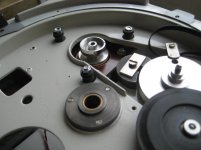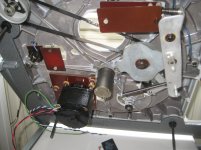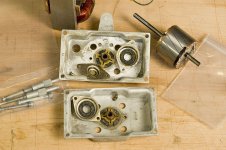Hello thrifttrust
kevinkr is probably right. If the belt has a thickness of 1 mm, the effective pulley diameter would be 16 mm, causing the platter to rotate too fast. Starting with a 135 mm pulley, the actual motor pulley diameter would be 14.1 mm.
I read somewhere that half the belt thickness should be considered when figuring the pulley diameters but I forgot where.
Sincerely,
Ralf
kevinkr is probably right. If the belt has a thickness of 1 mm, the effective pulley diameter would be 16 mm, causing the platter to rotate too fast. Starting with a 135 mm pulley, the actual motor pulley diameter would be 14.1 mm.
I read somewhere that half the belt thickness should be considered when figuring the pulley diameters but I forgot where.
Sincerely,
Ralf
Ah, that makes sense. Using the half belt thickness principle of .45mm that makes the big pulley effectively 135.45mm devided by 9 minus .45mm gives a small pulley diameter of of 14.6mm. I suspect the half thickness principle is a rule of thumb. when bent around a pulley the inside of the belt compresses and the outside stretches putting the effective diameter somewhere in the middle of the belt. No doubt the belt stretches more easily than it compresses so in the tighter small pulley wrap the effective diameter would be further out so my pulley ending up at 14.48 is understandable. It's a little disturbing to think that changing the thickness of the belt could change the speed.
Thanks for the insight guys.
Thanks for the insight guys.
I think you need to add a correction factor for the belt thickness.
The big pulley @ 135mm diam will only require a tiny correction.
The small pulley @ 14.48mm diam will require a bigger correction.
The effective driving/driven radius is not the actual pulley diameter, it is a diameter that approaches the middle of the belt thickness.
a 1mm thick belt on a 14.48mm pulley may have a driving diameter around 14.48 + 50% to 100% of thickness, i.e. 14.98 to 15.48mm diameter.
The correction is thus ~+3.5% to +7%
The correction for the driven pulley could be +0.4% to +0.8%
Then you need a "slip correction" factor.
Easier to just measure how many turns in 3minutes and re-order a smaller pulley.
The big pulley @ 135mm diam will only require a tiny correction.
The small pulley @ 14.48mm diam will require a bigger correction.
The effective driving/driven radius is not the actual pulley diameter, it is a diameter that approaches the middle of the belt thickness.
a 1mm thick belt on a 14.48mm pulley may have a driving diameter around 14.48 + 50% to 100% of thickness, i.e. 14.98 to 15.48mm diameter.
The correction is thus ~+3.5% to +7%
The correction for the driven pulley could be +0.4% to +0.8%
Then you need a "slip correction" factor.
Easier to just measure how many turns in 3minutes and re-order a smaller pulley.
Last edited:
kevinkr is probably right. If the belt has a thickness of 1 mm, the effective pulley diameter would be 16 mm, causing the platter to rotate too fast. Starting with a 135 mm pulley, the actual motor pulley diameter would be 14.1 mm.
I read somewhere that half the belt thickness should be considered when figuring the pulley diameters but I forgot where.
Sincerely,
Ralf
Here maybe :
Ralisation d'une platine de trs haute qualit, Verdier -1-
Pitty ! I"m working on another motor for the TD124 here is a prototype with a Bodine motor is not ready yet !
Volken
]
I gather you've been reading Simone's website. He uses a Bodine motor in his "Blackstone" turntable. That site caused me to take a look through the motor catalogs at Bodine Electric Company.
But you know, I've had Simone's new coils in 13943 for a couple of weeks now and the E50 just seems to get better and better. At this point, the motor is of no concern. I just play records without having any mechanical thoughts.
-Steve
It appears the Bodine motor shown is not currently in production. The closest I saw was this:
Bodine 1/40 HP 1800 RPM
At about 90mm square and 2 kilos it's rather large.
Bodine 1/40 HP 1800 RPM
At about 90mm square and 2 kilos it's rather large.
Interresting do you have a number from the motor on the picture its difficult do see, there are four wires for motor connection correct ?
In the motor powersupply I see two outputtransformers ?but no drivers and the crystal from the oscillator .
The balancing from the outer rotor from the Papst is important I shall try to fix tape on it and see what it does on the motor frequence from 24 Hz . At the E 50 motor a small unbalance translates in a higher vibration amplitude.
I have the Delphon GS5 turntable same designer as Morch ? It use no Papst motor.
Volken
Hi Volken,
The Motor used by Moerch is the 901 3520 001. It is a 24 Volts/50 hz unit (and I see it is also used in the Voyd turntables, including the mighty Valdi).
Hello Arch Stanton
That would have been the article, except that I don't speak french.
Sincerely,
Ralf
That would have been the article, except that I don't speak french.
Sincerely,
Ralf
Some news,
I received the idler wheel and the Teflon thrust plate from Audiosilente .
I am happy to tell you that the plater now stops in 2 minutes and 8 seconds !! With nylatron stopped in 45-52 seconds.... Same oil same quantity.
I think due to that Teflon thrust plate and the new idler wheel with the o ring ,the soundstage improved , became more wide and more holographic, sound is more dynamic and even more accurate,with even better PRAT than before.
Also less noisy due to new idler wheel an o ring.
That 124 is improving all the time and I am happy for that.
Tomorrow I will try to replace the platter discs to new ones and hear what will happen. The new fresh rubber or the silicon type might be more absorbing compared to old discs. It might give some better results as happened when I replaced the motor 's old rubber grommets with new fresh ones from Schopper.
The 50 years old grommets seemed excellent like new, but the real new absorbed vibrations of motor dramatically. I was impressed at that time with the results.
I do not know which ones of the two selections of plater discs to place for better results, the rubber or the silicone? I want to keep the beautiful sound of the 124 and absorb more noises . Maybe silicon discs are smoother than rubber and last for ever. Maybe rubber material, as it is like the original discs material , would keep the tt's sound signature that we like . I think by hearing I could check the difference of performance only. I would prefer to know before gluing them two times to check sound and a third to glue the better.
Have you any comments about the sound signature of those discs?
All the best
I received the idler wheel and the Teflon thrust plate from Audiosilente .
I am happy to tell you that the plater now stops in 2 minutes and 8 seconds !! With nylatron stopped in 45-52 seconds.... Same oil same quantity.
I think due to that Teflon thrust plate and the new idler wheel with the o ring ,the soundstage improved , became more wide and more holographic, sound is more dynamic and even more accurate,with even better PRAT than before.
Also less noisy due to new idler wheel an o ring.
That 124 is improving all the time and I am happy for that.
Tomorrow I will try to replace the platter discs to new ones and hear what will happen. The new fresh rubber or the silicon type might be more absorbing compared to old discs. It might give some better results as happened when I replaced the motor 's old rubber grommets with new fresh ones from Schopper.
The 50 years old grommets seemed excellent like new, but the real new absorbed vibrations of motor dramatically. I was impressed at that time with the results.
I do not know which ones of the two selections of plater discs to place for better results, the rubber or the silicone? I want to keep the beautiful sound of the 124 and absorb more noises . Maybe silicon discs are smoother than rubber and last for ever. Maybe rubber material, as it is like the original discs material , would keep the tt's sound signature that we like . I think by hearing I could check the difference of performance only. I would prefer to know before gluing them two times to check sound and a third to glue the better.
Have you any comments about the sound signature of those discs?
All the best
Help with my E50 Motor
Hello,
I've rebuilt a E50 motor before, but that was 8 years ago.
I'm now doing it again for my brothers early 124, (s/n 2972). I've torn the motor down, and am getting ready to put the bearing assemblies back together, and I'm not 100% sure of the order of the bearings, retainers, felts, etc. I know I've seen photos somewhere, (I think here.) Anyone have a link to view?
Thanks,
Gene
Hello,
I've rebuilt a E50 motor before, but that was 8 years ago.
I'm now doing it again for my brothers early 124, (s/n 2972). I've torn the motor down, and am getting ready to put the bearing assemblies back together, and I'm not 100% sure of the order of the bearings, retainers, felts, etc. I know I've seen photos somewhere, (I think here.) Anyone have a link to view?
Thanks,
Gene
Hello,
I've rebuilt a E50 motor before, but that was 8 years ago.
I'm now doing it again for my brothers early 124, (s/n 2972). I've torn the motor down, and am getting ready to put the bearing assemblies back together, and I'm not 100% sure of the order of the bearings, retainers, felts, etc. I know I've seen photos somewhere, (I think here.) Anyone have a link to view?
Thanks,
Gene
Unfortunately the link in post 58 to the Nifty's Thorens pages returns a 404 error (not found) and when I checked the wayback machine these pages had been deliberately excluded.
Take pictures of how you think it goes back together and post here, I and others can advise. It is fairly obvious, but bottom bushing narrow end faces up, top bushing narrow end faces down. Springs fit only one way and sit on the felts.
Impregnate the bushings in hot oil, allow to cool, make sure to really soak the felts prior to installation.
Use 20 SAE wt 3 in 1 electric motor for motor lubrication or 20wt non detergent motor oil if available in your area.
Impregnate the bushings in hot oil, allow to cool, make sure to really soak the felts prior to installation.
Use 20 SAE wt 3 in 1 electric motor for motor lubrication or 20wt non detergent motor oil if available in your area.
Hi Gene, give online metals a look - they may have something.
Another possibility is McMaster-Carr.
The original was nylatron, but other sufficiently hard materials should work well. User510 may be able to advise on other suitable materials, teflon may be ok, not sure - the ball bearing contact patch is small and the motor runs fast, ingredients for wear.
Another possibility is McMaster-Carr.
The original was nylatron, but other sufficiently hard materials should work well. User510 may be able to advise on other suitable materials, teflon may be ok, not sure - the ball bearing contact patch is small and the motor runs fast, ingredients for wear.
Hello,
I've rebuilt a E50 motor before, but that was 8 years ago.
I'm now doing it again for my brothers early 124, (s/n 2972). I've torn the motor down, and am getting ready to put the bearing assemblies back together, and I'm not 100% sure of the order of the bearings, retainers, felts, etc. I know I've seen photos somewhere, (I think here.) Anyone have a link to view?
Thanks,
Gene

More images of motor disassemble / assemble at link provided.
I've documented my motor refurb process a few times and photos of that can be found on my web site within the Td124 dept. Probably the page linked here is the most complete.
2078_E50
Also, I've written an overview on Td124 maintenance in general at this link:
TD124 Dept Scroll down to "notes on the TD124" and click that link.
-Steve
Last edited:
Steve,
Thank you for the reply. I remember your excellent site, (it's been a long time since I've been there), and now I have a question. Do you have a source for the thrust pad? Felts?
Thx
I was cutting my own felts from some heavy industrial felt (1/8inch thick) I'd sourced from McMaster-Carr. I used a punch to make those felts.
Although it is possible to clean/rinse and re-use the original felts if they're not too far gunked up.
An important factor to keep in mind is not to allow the felts to fit too tightly around the self-aligning motor bushings. Otherwise you'll have trouble getting the bushings into close alignment to the rotor shaft.
For the motor thrust pad material, I've been using Delrin. The Delrin I have is white in color. Like the felt, the Delrin sheet I sourced from Mcmaster-Carr, then use a plug cutter/drill press to cut the necessary sized circular disks from it.
-Steve
- Home
- Source & Line
- Analogue Source
- Restoring and Improving A Thorens TD-124 MKII


